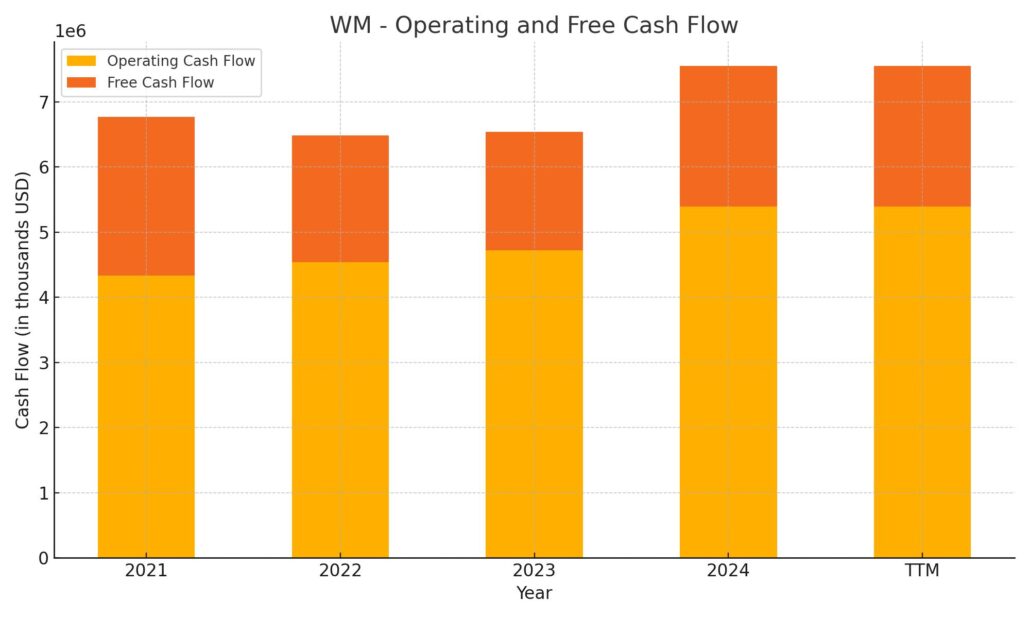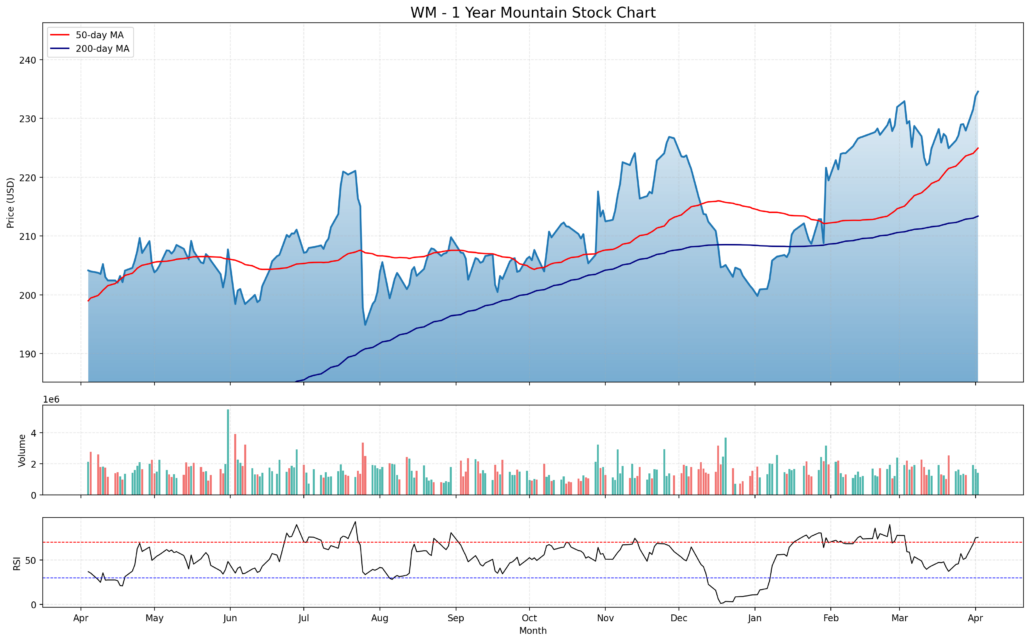Updated April 2025
Waste Management, Inc. (WM) is a company built on essential services, deeply embedded in the daily functioning of society. Whether the economy is booming or slowing, trash still needs to be picked up, and Waste Management does it better than anyone else in North America.
From landfills and recycling plants to a massive fleet of trucks, WM has a grip on nearly every step of the waste management process. But what often flies under the radar is just how profitable and shareholder-friendly this business really is. With strong operating margins, disciplined capital allocation, and a track record of rewarding investors, WM has quietly become one of the steadiest dividend payers around.
Recent Events
2024 was another strong year for WM, with total revenue climbing to $22.06 billion—a solid 13% jump compared to the prior year. That’s a big move for a company already operating at scale. But the real highlight came on the earnings side. Net income rose to $2.75 billion, and earnings per share hit $6.80, up more than 21% year-over-year.
Despite carrying a significant debt load—currently just under $25 billion—the company hasn’t missed a beat. It generated $5.39 billion in operating cash flow last year and still had $1.37 billion left over in levered free cash flow after covering its obligations. That kind of financial muscle is what allows WM to keep raising its dividend, year after year, without stretching itself thin.
Shares recently closed at $234.56, just shy of the 52-week high of $235.81. Investors seem to appreciate the stability and predictability WM brings to the table. The company’s stock has quietly climbed over 13% in the past year, outperforming the broader S&P 500. And with a beta of just 0.67, it moves far less than the overall market—ideal for dividend-focused portfolios that value low volatility.
🟢 Forward Dividend Yield: 1.41%
📈 5-Year Average Yield: 1.59%
💸 Forward Annual Dividend Rate: $3.30 per share
🧮 Payout Ratio: 44.05%
🔁 20 Years of Consecutive Dividend Increases
📆 Last Dividend Paid: March 28, 2025
⚠️ Ex-Dividend Date: March 14, 2025
Dividend Overview
WM’s dividend yield currently sits at 1.41%. It’s not sky-high, but it’s backed by a business that’s about as durable as they come. The latest hike brought the annual payout to $3.30 per share, up from $3.00 the year before—a healthy 10% increase. It’s this kind of steady growth that turns a modest starting yield into a meaningful income stream over time.
The company has now raised its dividend every single year for the last two decades. That consistency doesn’t happen by accident. It comes from a management team that understands the importance of returning capital to shareholders without sacrificing reinvestment in the business.
Compared to its five-year average yield of 1.59%, today’s yield is slightly lower, mostly due to the stock price climbing faster than dividend growth in recent months. For long-term investors, this can actually be a positive signal. It reflects confidence in the company’s future and suggests the market sees WM as a high-quality defensive name.
Dividend Growth and Safety
A 44% payout ratio is a sweet spot for a company like WM. It leaves room for future increases while maintaining flexibility. The dividend isn’t being forced higher at the expense of growth, and it’s not being artificially held low either. It’s just right—enough to reward shareholders without handcuffing the business.
Earnings growth has been strong, and with a forward P/E ratio of just over 30, investors are clearly paying up for quality. That’s not cheap, but it’s justified by the company’s stability and track record. WM’s return on equity is an impressive 36%, while return on assets comes in at 6.96%—both metrics that suggest the company is highly efficient at converting its operations into profits.
Debt is something to keep an eye on. Total debt of $24.94 billion against a current ratio of 0.76 suggests the company leans on its predictable cash flows to manage liabilities. And so far, that strategy is working. With EBITDA at $6.58 billion and strong interest coverage, the dividend doesn’t appear to be at risk.
Cash is tight on the balance sheet, with just $414 million on hand. But again, WM doesn’t need to hoard cash when it’s bringing in billions every quarter and has proven capable of managing debt while growing both earnings and dividends.
Another key strength? The business model. Waste collection doesn’t stop during economic downturns. That provides a floor under earnings and cash flow that’s hard to find in other industries. Even in turbulent markets, WM holds up.
And with pricing power in its contracts and operations that span both waste and recycling, the company can pass on cost increases without losing volume. That’s a rare advantage—and one that adds an extra layer of confidence to its dividend strategy.
This is a dividend that’s built to last.
Cash Flow Statement
Waste Management’s cash flow profile for the trailing twelve months shows a business that continues to generate strong and reliable internal cash generation. Operating cash flow hit $5.39 billion, reflecting consistent improvement over the past few years and a healthy uptick from the $4.72 billion in 2023. This steady climb supports the company’s capital spending, which reached $3.23 billion, and still left $2.16 billion in free cash flow—plenty of room to support dividends and operational needs without leaning heavily on outside financing.

On the investing side, the company recorded a significant outflow of $10.6 billion, which is much higher than in previous years. This likely reflects large-scale investments in infrastructure or acquisitions. Interestingly, financing cash flow came in at a positive $5.15 billion, driven by $24.6 billion in new debt issuance—partially offset by $17.9 billion in repayments. The company also spent modestly on share repurchases compared to prior years. Despite the aggressive investment activity, WM ended the period with $487 million in cash, a slight dip from the year before but still in line with its capital-efficient approach.
Analyst Ratings
🟩 Waste Management (WM) has received a consensus rating of “Moderate Buy” from analysts. 🟨 This reflects a fairly balanced sentiment, with 12 analysts rating the stock a “Buy” and 6 opting to “Hold.” Interestingly, none have issued a “Sell” rating, which speaks to the general confidence in WM’s long-term fundamentals.
🎯 The average 12-month price target is $242.67, suggesting a modest upside of about 3.8% from the current trading levels. 🎯 Price targets range from a low of $225.00 to a high of $257.00, showing a relatively tight band of expectations that mirrors WM’s reputation as a stable performer in the market.
📈 Recent upgrades have been driven by strong earnings performance and efficient cost controls. WM continues to show dependable revenue growth while making smart capital investments, particularly in areas like recycling and renewable energy. These efforts align well with long-term sustainability goals and have helped reinforce the bullish case for the stock.
⚠️ On the other hand, the few downgrades issued recently point to macroeconomic uncertainties and WM’s significant debt load. Concerns have also been raised about potential headwinds in commodity-linked revenue streams, especially if market prices shift unfavorably in the recycling segment.
💡 Even with these cautions, the majority of analysts remain optimistic, seeing WM as a dependable name with durable cash flows, a strong competitive position, and a clear vision for the future.
Earning Report Summary
Waste Management wrapped up 2024 with a strong finish, showing why it continues to be a steady hand in a sector that doesn’t always get the spotlight. The company’s fourth-quarter revenue came in at $5.89 billion, which marked a 13% increase compared to the same time last year. That kind of top-line growth is no small feat for a business of WM’s size. It was largely powered by strength in their collection and disposal services, where smart pricing and continued demand helped drive performance.
Solid Margins and Operational Gains
Even though earnings per share for the quarter came in at $1.70—slightly below what some expected—the overall profitability story is still intact. Waste Management managed to expand margins in its core business, hitting a 30% margin in the collection and disposal segment for the first time ever. That’s a big milestone and speaks to how well the company is managing costs and optimizing operations, even as it continues to grow.
Progress on Sustainability Goals
WM isn’t just collecting trash—it’s pushing forward on the environmental front too. Over the past year, the company completed more than half of its planned recycling automation upgrades, adding 1.5 million tons of annual recycling capacity across North America. On top of that, it brought three renewable natural gas projects online, with four more expected to follow soon. These moves show WM’s long-term commitment to sustainability, and they’re setting the stage for future revenue streams in a world that’s increasingly focused on clean energy and resource recovery.
In a nod to investors, the company raised its dividend again—this time by 10%—bringing the quarterly payout up to $0.825 per share for 2025. That’s a healthy bump and a signal that WM remains confident in its cash flow generation and overall financial health.
All in all, the latest earnings report paints the picture of a company that’s hitting its stride—growing revenues, managing costs well, making forward-thinking investments, and still returning capital to shareholders. Waste Management continues to be a name that delivers, quarter after quarter.
Chart Analysis

WM has been on a steady climb over the past year, and the chart tells a story of strength, resilience, and growing investor confidence.
Price Momentum and Moving Averages
The price has consistently moved above its 200-day moving average since the late summer months, which is a positive sign of sustained upward momentum. That long-term trend line has acted as a base throughout the year, with the stock bouncing off it several times, most notably in October and again around early January. The 50-day moving average dipped below the 200-day line during a brief stretch in late 2023 but has since recovered, now trending comfortably higher. This crossover and rebound often mark a shift in sentiment, and that’s reflected in the strong run-up seen since February.
Volume and Market Participation
Trading volume has remained fairly steady with occasional surges, especially during price dips. That spike in volume during declines shows buyers stepping in at lower levels—another indication of underlying support. There hasn’t been a major volume sell-off, even when the price pulled back, which suggests investors have been holding rather than exiting positions.
RSI Behavior and Market Strength
The Relative Strength Index (RSI) spent most of the year in the middle to upper ranges, rarely falling into oversold territory. Recently, it’s moved closer to overbought levels, but not in a dramatic or overheated way. This suggests strong buying interest without panic chasing. Even when RSI dipped below 30 around December, it rebounded quickly, aligning with the price recovery that followed in January.
WM’s recent push toward its one-year high, combined with firm technical support and a steady rise in volume-backed buying, signals continued confidence in the stock. The chart leans toward strength, not speculation.
Management Team
Waste Management (WM) is led by a team that brings a mix of deep industry knowledge and steady financial oversight. At the top is CEO Jim Fish, who’s been with the company for more than two decades. He’s held the CEO role since 2016, and under his leadership, the company has not only maintained its position as an industry leader but also pushed into new areas like renewable energy and recycling automation. His background in finance is evident in the way capital is deployed—carefully and with a long-term mindset.
The executive team is filled with individuals who’ve grown within the company, which tends to reflect a culture of consistency and accountability. That experience pays off, especially when navigating regulatory shifts or managing large infrastructure projects. WM’s management isn’t known for chasing headlines. Instead, they focus on hitting their targets, building new capabilities, and maintaining operational discipline.
There’s also been a noticeable emphasis on ESG goals. The team has laid out a clear strategy for reducing emissions and expanding sustainability initiatives, and they’ve stuck to it. From an investor standpoint, this kind of transparency and follow-through helps build confidence over time.
Valuation and Stock Performance
At a recent price of around $234, WM is trading close to its 52-week high. The stock has moved steadily higher over the past year, delivering roughly 13% in gains during a period when many names struggled for direction. That kind of performance doesn’t come from hype—it reflects strong fundamentals and predictable growth.
Valuation-wise, WM isn’t cheap. The current price-to-earnings ratio is above 34, and the forward P/E sits just over 30. Those numbers suggest investors are willing to pay a premium, and for good reason. WM’s business model delivers consistent cash flow, backed by long-term contracts and low customer turnover. The company’s enterprise value to EBITDA ratio is in the upper teens, placing it firmly in the premium category for industrials.
But the market seems comfortable with that. The stock tends to trade with less volatility than the broader market, thanks in part to a beta under 0.70. It’s not a fast mover, but it’s steady—and that steadiness has been rewarded.
Institutional investors hold a significant portion of the float, and that level of ownership adds to the stability. There’s a high degree of trust in management and confidence that WM will keep doing what it’s done for decades: grow steadily and return capital to shareholders.
Risks and Considerations
Even companies with strong track records face risks, and WM is no exception. The most notable is its debt load. With nearly $25 billion in total debt and a debt-to-equity ratio well over 300%, the balance sheet leans heavily on leverage. So far, strong operating cash flow has more than covered debt servicing, but higher interest rates or tightening credit conditions could change that picture.
Regulatory shifts are another area to watch. Waste and recycling are governed by a maze of federal, state, and local regulations. Any tightening around landfill emissions, recycling mandates, or environmental compliance could require costly upgrades or limit operational flexibility. WM has generally been proactive in these areas, but changes in policy can still catch even the most prepared companies off guard.
The recycling side of the business is also vulnerable to commodity price swings. When the prices for materials like aluminum or cardboard fall, the company’s earnings from recycling can take a hit. That part of the business adds some volatility to an otherwise predictable model.
Operational costs are another factor. Fuel, wages, and maintenance for one of the largest fleets in North America don’t come cheap. Any extended inflationary period could pressure margins. And while WM is actively investing in fleet upgrades and efficiency tools, those improvements take time to deliver savings.
Then there’s the capital spending tied to renewable energy and automation. These are long-term bets with upfront costs. If execution lags or timelines stretch, there could be temporary pressure on earnings or free cash flow. The strategy is sound, but the rollout will need to be closely watched.
Final Thoughts
Waste Management is the kind of company that doesn’t chase trends—it builds long-term value. The business model is anchored in necessity, supported by municipal contracts, and enhanced by operational efficiency. That formula has worked for decades, and there’s little reason to think it won’t continue to.
The company’s investments in renewable energy, digital optimization, and environmental sustainability show it’s not content to just maintain the status quo. WM is thinking about the next 10 to 20 years, and that kind of vision is rare in today’s market.
Yes, the stock trades at a premium, but the quality of the earnings and consistency of cash flow help justify that. The management team knows how to steer through economic shifts, maintain margins, and deliver growing returns to shareholders. It’s not the kind of name that swings for the fences—it’s the kind that hits steady doubles, year after year.
In a market full of uncertainty, WM continues to look like a name that delivers not just stability, but quiet, disciplined growth.

